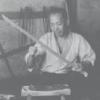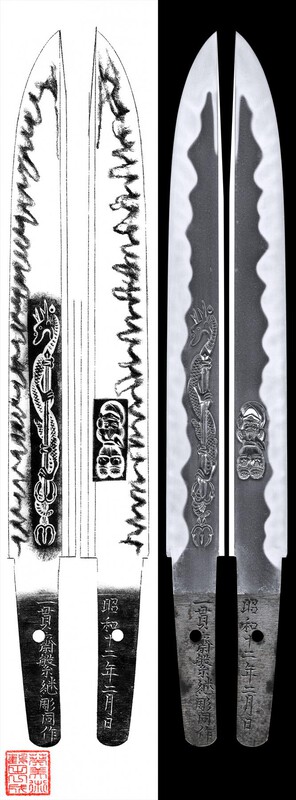-
Posts
2,726 -
Joined
-
Last visited
-
Days Won
41
Content Type
Profiles
Forums
Events
Store
Downloads
Gallery
Posts posted by SwordGuyJoe
-
-
That blade is the reason he’s now on the list. I’ve looked at a lot of his work since then and really like it!
-
Our next meeting will be in conjunction with The Arts and Arms of the Samurai show. As with last year, Markus Sesko and Chris Bowen have graciously offered their time and expertise to help make this a memorable event. Information on the show can be found HERE
JSC-MW Meeting Details:
The focus of our meeting will be the history of the tanto and a focus on it's role from the Meiji - Showa era. We will also be providing a display of Gendai tanto that will be one of, if not the largest display of its kind in the West.
Entry Cost:
As this is a fund raising event for the JSC-MW, I will ask for a modest $20 donation to attend the lectures and see the display. If you're unable to attend the lectures and would like to view the display only, I would request a $10 donation.
Please see below for topics and schedule:
Saturday, October 20th from 2:00 pm - 6:00 pm
2:00: Room Open
2:15: Markus Sesko
The history of the Tanto, Classification, Types and Styles, including Q&A
3:00: Chris Bowen
A study and lecture on the Gendai tanto (Meiji through Showa), including Q&A
4:00 - 6:00: Display of Gendai Tanto
This conglomeration of tanto, created from the Meiji through Showa eras, will constitute one of, if not the largest displays of it's kind ever in the West. Don't miss this amazing opportunity to view blades created by the top craftsmen of their time.
More Information please feel free to CONTACT ME -
Most know my favorites, but here are my favorite post war groups and smith:
- Miyairi Group: Fujiyasu Masahira
- - Lots of amazing postwar smiths in this group, but Fujiyasu is my favorite. I believe he stopped competing, so he’ll never be mukansa, but he sure has the talent for it.
- Yoshihara group: Ono Yoshimitsu, followed closely by Yoshihara Shoji (Sandai Kuniie)
- - Some prefer Yoshindo or Shoji Yoshihara, but for my dollar, Ono Sensei was the best of the group and much like the Gassan line, even with Yoshindo’s son passing away, the school still has strong representation
- Gassan’s: This is another close one, but I prefer Enomoto’s work
- Ikkansai’s: This is my absolute favorite of all schools! I’ve had the privilege of having a sword by most of the big name guys, many post war. While I certainly have to give Ozawa Masatoshi an honorable mention - as his work is as good or better than most of the era, though I don’t believe he did make mukansa, my favorite post war smith (smith that made most of his work post war), would be Sakai Ikkansai Shigemasa. His Soden-bizen work, coupled with his skill at horimono, saves him a spot at the top of my list.
- - I should also state that Shigemasa’s best student (IMO), Takahana Ikkansai Shigehisa is quite good as well. Not as consistent as others on this list, but when a sword comes together, it REALLY comes together. Much like Masahira above, I haven’t seen Shigehisa listed in competition results for a few years and I would think if he’d compete, he would at least place.
- Showa Kongobyoe: Tanigawa Moriyoshi
- - My absolute favorite Smith that I don’t collect. While he is known for his Kiyomaro utsushi, his Soden Bizen work is what puts him near the top of the list for me.
This is my list and if I’d own a sword from each of these groups, it would be these guys. I also like the Higo Akamatsu Taro smiths, who do a bunch of Kiyomaro utsushi, but they don’t make my top favorites.
-
 8
8
-
-
Nagase Yoshinaga Saku (長瀬義永作). He was a smith that worked in Seki / Gifu.
-
 1
1
-
-
Thank you guys. As far as I understand you consider it to be a shinshinto blade but not good enough to be worth giving it a proper polish?
It’s tough to say conclusively what era this is from the pictures. The sugata to me says shinto (perhaps Kanbun), but it could easily be shinshinto. To your question of cut or polish. I’m a collector and not practitioner, so as such, I’d say do not cut with it because you run the risk of damaging the blade. That said, I also realize it is your sword and you can do with it what you like.
I would propose a third option and a strong recommendation. Send it to shinsa before deciding on which of the two options to engage on. There are shinsa’s in The US nearly every year now, if you need a faster answer, you could send to Japan. You’ll be into the blade an extra few hundred dollars, but the polish is decent enough that an opinion of what it is, when it was forged, and the group and potentially the exact smith that made it should be able to be rendered.
With this, you will be able to know how financially viable a polish is and if it isn’t, the selling the sword should be “easier” as you can provide additional information that may help buyer decide to shell out the money. But again, I wouldn’t cut with it.
-
Good luck!
-
 1
1
-
-
Congrats to you and the buyer alike.
-
 1
1
-
-
Oh i know the code well. But every time Karl posts something, I think, “This is the one that’s finally going to click!” Sadly, it hasn’t yet.
-
Ive studied Kanehide blades quite a bit and outside of just that he isn’t a guy that would be faked, the mei is good.
-
 1
1
-
-
What in the world are you trying to say? I can’t make heads or tails out of your post or your pics. I’m just trying to understand...
-
 2
2
-
-
Nice sword and interesting that the horimono was added later. Pretty steep price tag for the length of the sword, though I agree that it is lovely!
-
The smith who stamped masayuki was the showa smith Ijima Ko. Kiyomaro did not stamp his mei. Pictures of the sword would help as well.
Masayuki (正幸), Shōwa (昭和, 1926-1989), Yamanashi – „Masayuki“ (正幸), civilian name „Ijima Kō“ (飯島幸)
-
 1
1
-
-
The best part is that I haven’t even seen the thing!
-
 3
3
-
-
All,
A while back, I purchased a tanto with horimono by Kasama Ikkansai Shigetsugu. The tanto came with Tokubetsu Hozon koshirae. It didn’t have papers, so I figured while it was there, I’d send it through shinsa. And since I was submitting, I may as well do dual TH and Hozon submission (a practice for Gendaito that I’ve been told is a foolish waste of money, as TH is VERY seldom awarded to gendaito). Well, news came back that the sword passed TH! Here is some info on the sword and a pic of the blade and koshirae.
Habaki :Gold wrapped single habaki.
Blade length : 25.0 cm or 9.84 inches.
Mekugi : 1
Width at the hamachi : 2.66cm or 1.04 inches.
Kasane : 0.54cm or 0.21 inches.
Era : Showa 12 year (1937).
Shape : The blade is rather wide and thick with Horimono.
On the front, the god of the Daikokusama
and Kenmakiryu on the reverse side.
Jigane :Koitame hada well grained with jinie attach
and visible to see the texture well.
Hamon :Niedeki rather deep nioikuchi Choji midare.
Boshi is midarekomi and turns back.
-
 19
19
-
-
I was thinking Yokoyama group as well.
-
Would we call this a true sanbonsugi? Looks more like a loose choji to me, which would line up more to Bizen then would sanbonsugi. But Ray is correct that some of the shinshinto smiths practiced multiple deki, frequently having one that they’re best known for.
-
X X shi masatoshi. Not sure on the X’s but I’m sure someone will be along to help further. There were a few smiths that used the masatoshi (正寿) kanji on your sword.
-
Sorry to disagree, but this is Kaneharu (兼玄). Here is information from Markus’ index:
Kaneharu (兼玄), Shōwa (昭和, 1926-1989), Gifu – „Kaneharu“ (兼玄), civilian name „Tomatsu Naotarō“ (戸松直太郎), born October 14th 1917, he worked as guntō smith
-
 2
2
-
-
The second blade is Teruhide. He was a ww2 era sword smith.
I should add - Ishido Teruhide.
-
Shoot. Good call guys!
-
Ends with moriuji imo.
-
HOLD
Once the sale is completed, I will donate to the board.
-
 3
3
-
-
Yup. Kojima Katsumasa is your guy
-
 1
1
-
-
The mei reads (No)shu seki ju Kojima Katsumasa saku. It looks like you’re picture is missing the first kanji, but I’d bet it’s there.
Katsumasa (勝正), Shōwa (昭和, 1926-1989), Gifu – „Katsumasa“ (勝正), civilian name „Kojima Shichi´emon“ (小島七右衛門), born October 20th 1892, he studied under Kaneyoshi (兼吉), worked as a guntō smith and died September 22nd 1947
-
 4
4
-





Jsc-Mw: Tanto Lecture And Huge Display
in Sword Shows, Events, Community News and Legislation Issues
Posted
Bump. As we are trying to make this a fantastic display, If anyone is interested in including their Tanto in the display, please PM me or email at info(at)jsc-mw.com.
Event page: https://www.jsc-mw.com/meetingsandevents